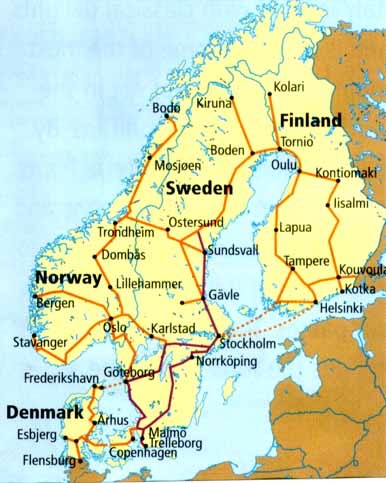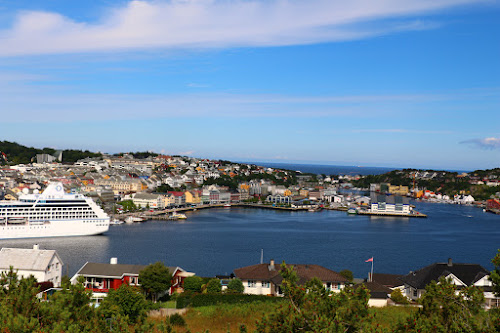As we entered the fjord that lead us into the harbor at Alesund, Norway, we realized it would be another rainy day. We set out around 11:00 AM in search of the Hop On Hop Off bus stop. At noon we boarded the next bus and stayed on it while touring the town's sites. Alesund is big in the fishing and shipping industries for this area of Norway. We soon reached the top of Mount Aksla where we got out to take some photos. Then it started raining hard, and we realized that going back to the ship on the bus was a good option.
The waterfront in Alesund, Norway.
Another view of the waterfront with Mt. Aksla in the center background.
Yes, it's supposed to be summer here too, but someone forgot to tell Mother Nature to spread a little warmth here in Scandinavia. The temps were in the 50's, and yes, that's snow in the distant mountains.
I like this shot of Alesund from the top of Mt. Aksla because it shows how compact the city center is. The city actually takes up several islands. City center burned down in 1904 leaving more than 10,000 people homeless, and it was rebuiilt in the art nouveau style.
This is a shot looking back into the fjord.
The weather in Trondheim was much the same as in Alesund. This cathedral was built in 1070, and it was a pilgrimage site back in medieval times.
We walked over to this bridge
We crossed this bridge and made our way up to the fortress.
From the fortress we were able to take in wide expanses of the city below and the surrounding countryside.
A shot of the Trondheim marina near the harbor.
Looking back into the fjord from our cabin on the ship.
This is the harbor in Hammerfest, Norway. This city's claim to fame is that it is the northernmost city in the world at 70 degrees north latitude. As you can see, the weather is unrelenting with temperatures in the 50's and on-and-off rain.
The residents of Hammerfest have been up in arms over the herds of reindeer that make their way down into town dropping their feces and urine inside the town. They built barriers up on the hillsides to try to deter the reindeer but with only partial results.
Looking back into the fjord from above Hammerfest.
This is the Meridian Column erected in 1854 to commemorate the first measurement of the earth's exact shape and size. This was accomplished by the King Oscar II. Sweden and Russia also took part. At the bottom of the writing you can see that it sits at 70 degrees north lattitude.





















































